Understanding and Leading Change: Tesco Case Study Report
VerifiedAdded on 2023/01/13
|14
|4437
|39
Report
AI Summary
This report provides a detailed analysis of organizational change, focusing on Tesco as a case study. It begins by examining the impact of change on organizational strategies and operations, highlighting examples from ASDA and Tesco. The report then delves into the drivers of change, both internal and external, and their effects on individual and team behavior, along with the role of leadership. It explores measures to minimize the negative impacts of change on organizational behavior, emphasizing participative management, learning culture, and effective communication. The report utilizes SWOT and PEST analyses to understand the change drivers and their influences. Furthermore, it discusses organizational responses to change through the Burke-Litwin model, identifying factors crucial for effective change management within Tesco. The analysis continues by identifying barriers to change and their influence on leadership decision-making, including a force field analysis. Finally, the report evaluates various leadership approaches and change models, assessing their effectiveness in delivering successful organizational change and provides a conclusion with recommendations for effective change implementation and planning.

Understanding And
Leading Change
Leading Change
Paraphrase This Document
Need a fresh take? Get an instant paraphrase of this document with our AI Paraphraser
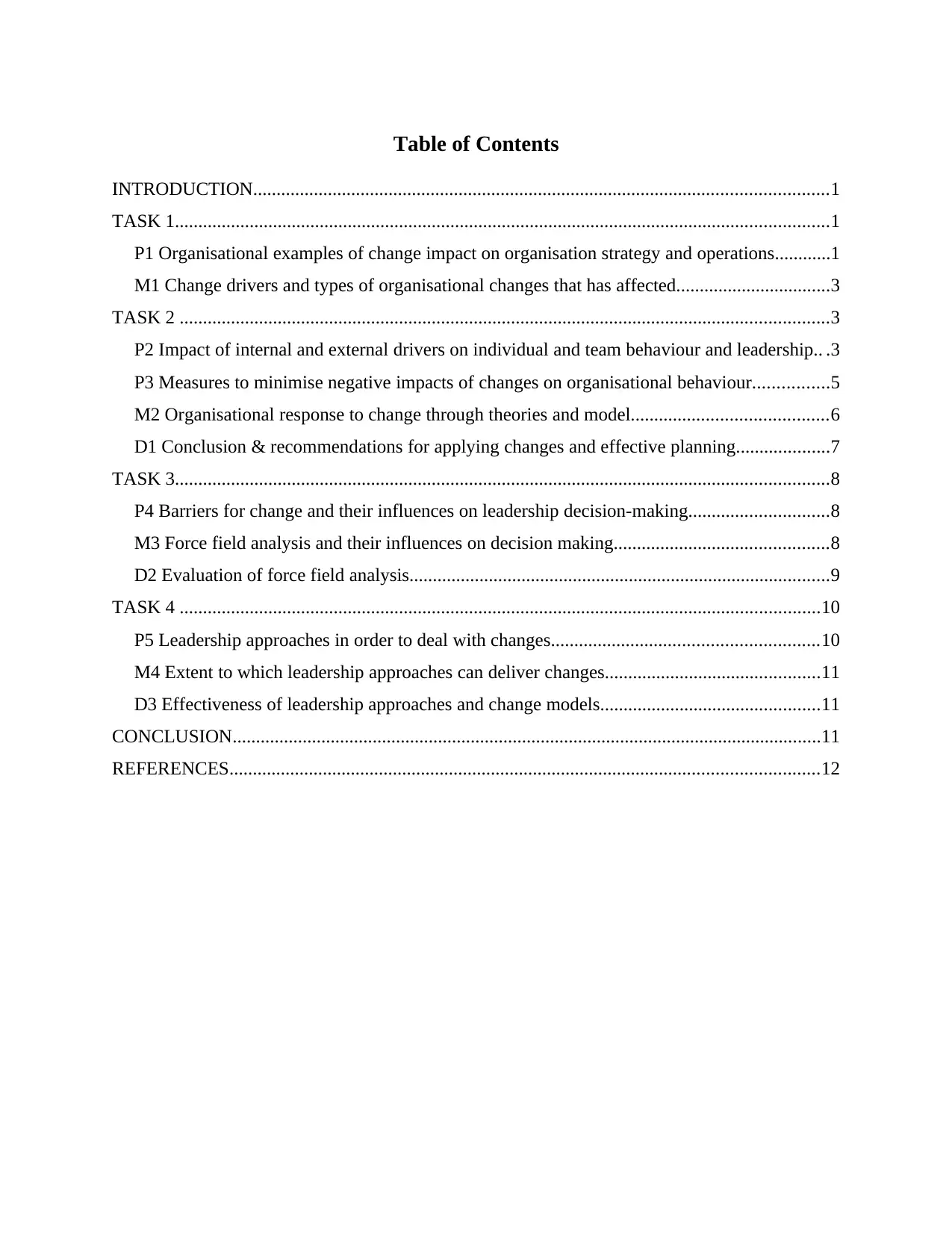
Table of Contents
INTRODUCTION...........................................................................................................................1
TASK 1............................................................................................................................................1
P1 Organisational examples of change impact on organisation strategy and operations............1
M1 Change drivers and types of organisational changes that has affected.................................3
TASK 2 ...........................................................................................................................................3
P2 Impact of internal and external drivers on individual and team behaviour and leadership.. .3
P3 Measures to minimise negative impacts of changes on organisational behaviour................5
M2 Organisational response to change through theories and model..........................................6
D1 Conclusion & recommendations for applying changes and effective planning....................7
TASK 3............................................................................................................................................8
P4 Barriers for change and their influences on leadership decision-making..............................8
M3 Force field analysis and their influences on decision making..............................................8
D2 Evaluation of force field analysis..........................................................................................9
TASK 4 .........................................................................................................................................10
P5 Leadership approaches in order to deal with changes.........................................................10
M4 Extent to which leadership approaches can deliver changes..............................................11
D3 Effectiveness of leadership approaches and change models...............................................11
CONCLUSION..............................................................................................................................11
REFERENCES..............................................................................................................................12
INTRODUCTION...........................................................................................................................1
TASK 1............................................................................................................................................1
P1 Organisational examples of change impact on organisation strategy and operations............1
M1 Change drivers and types of organisational changes that has affected.................................3
TASK 2 ...........................................................................................................................................3
P2 Impact of internal and external drivers on individual and team behaviour and leadership.. .3
P3 Measures to minimise negative impacts of changes on organisational behaviour................5
M2 Organisational response to change through theories and model..........................................6
D1 Conclusion & recommendations for applying changes and effective planning....................7
TASK 3............................................................................................................................................8
P4 Barriers for change and their influences on leadership decision-making..............................8
M3 Force field analysis and their influences on decision making..............................................8
D2 Evaluation of force field analysis..........................................................................................9
TASK 4 .........................................................................................................................................10
P5 Leadership approaches in order to deal with changes.........................................................10
M4 Extent to which leadership approaches can deliver changes..............................................11
D3 Effectiveness of leadership approaches and change models...............................................11
CONCLUSION..............................................................................................................................11
REFERENCES..............................................................................................................................12
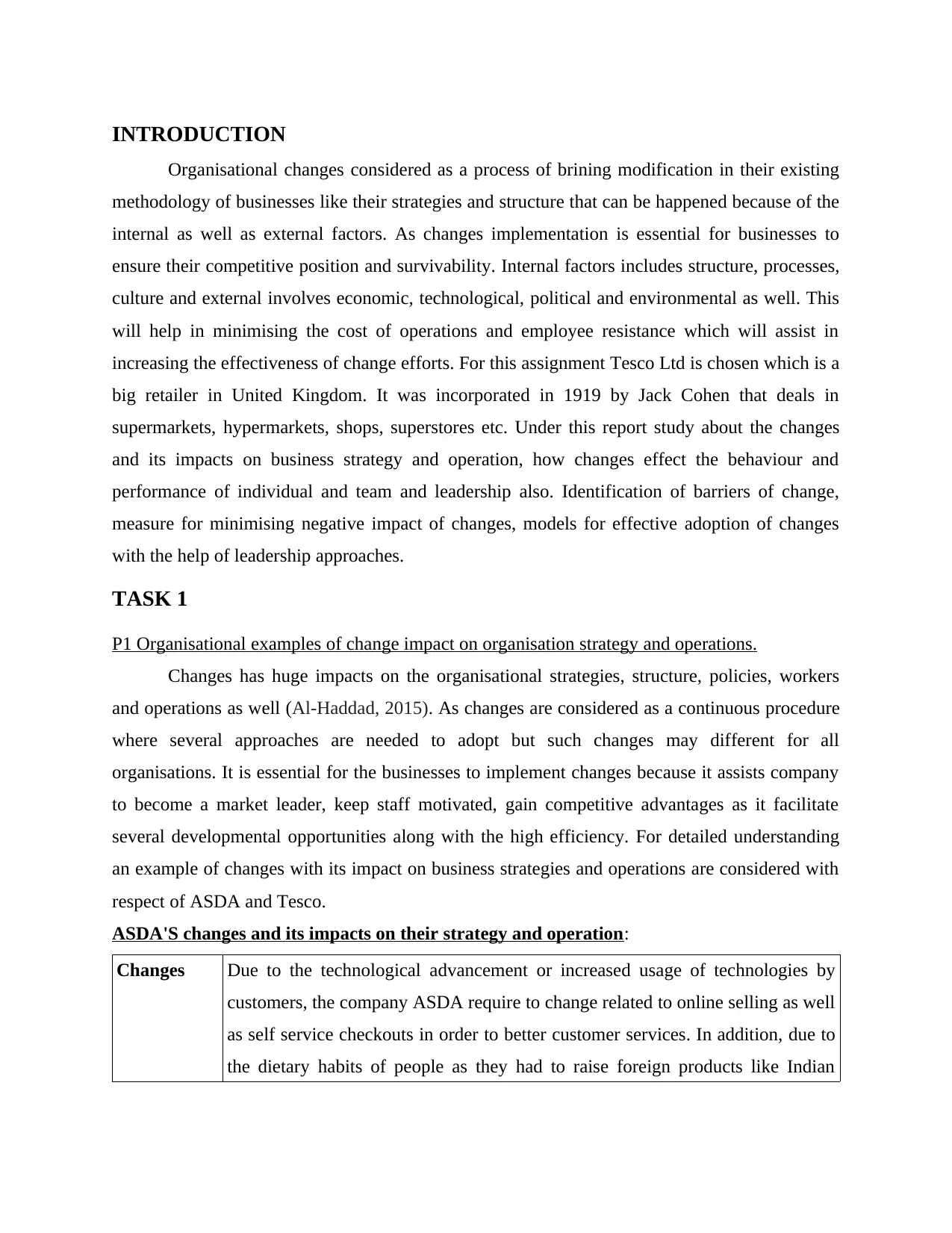
INTRODUCTION
Organisational changes considered as a process of brining modification in their existing
methodology of businesses like their strategies and structure that can be happened because of the
internal as well as external factors. As changes implementation is essential for businesses to
ensure their competitive position and survivability. Internal factors includes structure, processes,
culture and external involves economic, technological, political and environmental as well. This
will help in minimising the cost of operations and employee resistance which will assist in
increasing the effectiveness of change efforts. For this assignment Tesco Ltd is chosen which is a
big retailer in United Kingdom. It was incorporated in 1919 by Jack Cohen that deals in
supermarkets, hypermarkets, shops, superstores etc. Under this report study about the changes
and its impacts on business strategy and operation, how changes effect the behaviour and
performance of individual and team and leadership also. Identification of barriers of change,
measure for minimising negative impact of changes, models for effective adoption of changes
with the help of leadership approaches.
TASK 1
P1 Organisational examples of change impact on organisation strategy and operations.
Changes has huge impacts on the organisational strategies, structure, policies, workers
and operations as well (Al-Haddad, 2015). As changes are considered as a continuous procedure
where several approaches are needed to adopt but such changes may different for all
organisations. It is essential for the businesses to implement changes because it assists company
to become a market leader, keep staff motivated, gain competitive advantages as it facilitate
several developmental opportunities along with the high efficiency. For detailed understanding
an example of changes with its impact on business strategies and operations are considered with
respect of ASDA and Tesco.
ASDA'S changes and its impacts on their strategy and operation:
Changes Due to the technological advancement or increased usage of technologies by
customers, the company ASDA require to change related to online selling as well
as self service checkouts in order to better customer services. In addition, due to
the dietary habits of people as they had to raise foreign products like Indian
Organisational changes considered as a process of brining modification in their existing
methodology of businesses like their strategies and structure that can be happened because of the
internal as well as external factors. As changes implementation is essential for businesses to
ensure their competitive position and survivability. Internal factors includes structure, processes,
culture and external involves economic, technological, political and environmental as well. This
will help in minimising the cost of operations and employee resistance which will assist in
increasing the effectiveness of change efforts. For this assignment Tesco Ltd is chosen which is a
big retailer in United Kingdom. It was incorporated in 1919 by Jack Cohen that deals in
supermarkets, hypermarkets, shops, superstores etc. Under this report study about the changes
and its impacts on business strategy and operation, how changes effect the behaviour and
performance of individual and team and leadership also. Identification of barriers of change,
measure for minimising negative impact of changes, models for effective adoption of changes
with the help of leadership approaches.
TASK 1
P1 Organisational examples of change impact on organisation strategy and operations.
Changes has huge impacts on the organisational strategies, structure, policies, workers
and operations as well (Al-Haddad, 2015). As changes are considered as a continuous procedure
where several approaches are needed to adopt but such changes may different for all
organisations. It is essential for the businesses to implement changes because it assists company
to become a market leader, keep staff motivated, gain competitive advantages as it facilitate
several developmental opportunities along with the high efficiency. For detailed understanding
an example of changes with its impact on business strategies and operations are considered with
respect of ASDA and Tesco.
ASDA'S changes and its impacts on their strategy and operation:
Changes Due to the technological advancement or increased usage of technologies by
customers, the company ASDA require to change related to online selling as well
as self service checkouts in order to better customer services. In addition, due to
the dietary habits of people as they had to raise foreign products like Indian
⊘ This is a preview!⊘
Do you want full access?
Subscribe today to unlock all pages.

Trusted by 1+ million students worldwide

Mexican because of they want new food.
Impact on
strategy
For implementing changes company have to make plans for providing training to
their employees that will impact on their current strategies. ASDA has to adopt
product development and market penetration as a strategies through which they
launch new and unique products in their present market as well as brings some
attractive innovation (Beech, 2017).
Impact on
operations
The company require to focus on information management mechanism and data
management system as well because they gone online and implements
technological advancement for their self service checkouts that will influence
existing workers and their working manner.
Change
drivers
This includes the technology change and sociocultural changes.
Tesco's changes and its impacts on their strategy and operation:
Changes Due to the raising unemployment, demand of Tesco's goods is anticipated to
decline as in order to overcome from unemployment issue the company creates
employment opportunities by opening their new stores easily because government
supports and promotes large retailers in order to create several job opportunities.
Impact on
strategy
Tesco was to emphasise on their current business by facilitating goods at low cost
but due to the occurrence of changes they require to modified their emphasises
towards the enlargement of business by opening new stores.
Impact on
operations
This kind of changes are considered as a developmental changes as it will increase
their current customer base and stores will be well accessible, hence fund
requirements and inventory demand that will be increase (Burke, 2017).
Change
drivers
Tesco's changes are related to the political pressure and economical aspects.
Impact on
strategy
For implementing changes company have to make plans for providing training to
their employees that will impact on their current strategies. ASDA has to adopt
product development and market penetration as a strategies through which they
launch new and unique products in their present market as well as brings some
attractive innovation (Beech, 2017).
Impact on
operations
The company require to focus on information management mechanism and data
management system as well because they gone online and implements
technological advancement for their self service checkouts that will influence
existing workers and their working manner.
Change
drivers
This includes the technology change and sociocultural changes.
Tesco's changes and its impacts on their strategy and operation:
Changes Due to the raising unemployment, demand of Tesco's goods is anticipated to
decline as in order to overcome from unemployment issue the company creates
employment opportunities by opening their new stores easily because government
supports and promotes large retailers in order to create several job opportunities.
Impact on
strategy
Tesco was to emphasise on their current business by facilitating goods at low cost
but due to the occurrence of changes they require to modified their emphasises
towards the enlargement of business by opening new stores.
Impact on
operations
This kind of changes are considered as a developmental changes as it will increase
their current customer base and stores will be well accessible, hence fund
requirements and inventory demand that will be increase (Burke, 2017).
Change
drivers
Tesco's changes are related to the political pressure and economical aspects.
Paraphrase This Document
Need a fresh take? Get an instant paraphrase of this document with our AI Paraphraser
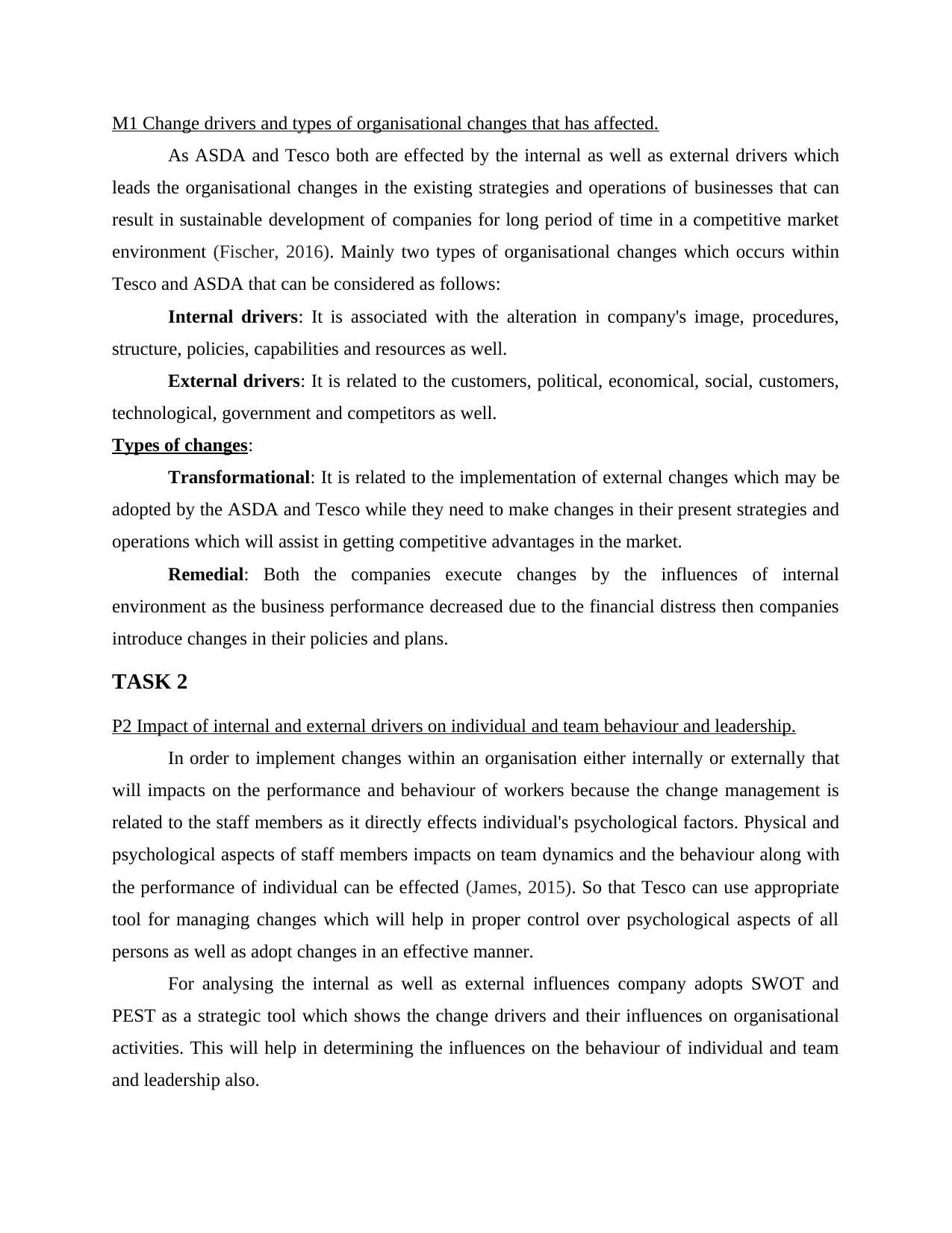
M1 Change drivers and types of organisational changes that has affected.
As ASDA and Tesco both are effected by the internal as well as external drivers which
leads the organisational changes in the existing strategies and operations of businesses that can
result in sustainable development of companies for long period of time in a competitive market
environment (Fischer, 2016). Mainly two types of organisational changes which occurs within
Tesco and ASDA that can be considered as follows:
Internal drivers: It is associated with the alteration in company's image, procedures,
structure, policies, capabilities and resources as well.
External drivers: It is related to the customers, political, economical, social, customers,
technological, government and competitors as well.
Types of changes:
Transformational: It is related to the implementation of external changes which may be
adopted by the ASDA and Tesco while they need to make changes in their present strategies and
operations which will assist in getting competitive advantages in the market.
Remedial: Both the companies execute changes by the influences of internal
environment as the business performance decreased due to the financial distress then companies
introduce changes in their policies and plans.
TASK 2
P2 Impact of internal and external drivers on individual and team behaviour and leadership.
In order to implement changes within an organisation either internally or externally that
will impacts on the performance and behaviour of workers because the change management is
related to the staff members as it directly effects individual's psychological factors. Physical and
psychological aspects of staff members impacts on team dynamics and the behaviour along with
the performance of individual can be effected (James, 2015). So that Tesco can use appropriate
tool for managing changes which will help in proper control over psychological aspects of all
persons as well as adopt changes in an effective manner.
For analysing the internal as well as external influences company adopts SWOT and
PEST as a strategic tool which shows the change drivers and their influences on organisational
activities. This will help in determining the influences on the behaviour of individual and team
and leadership also.
As ASDA and Tesco both are effected by the internal as well as external drivers which
leads the organisational changes in the existing strategies and operations of businesses that can
result in sustainable development of companies for long period of time in a competitive market
environment (Fischer, 2016). Mainly two types of organisational changes which occurs within
Tesco and ASDA that can be considered as follows:
Internal drivers: It is associated with the alteration in company's image, procedures,
structure, policies, capabilities and resources as well.
External drivers: It is related to the customers, political, economical, social, customers,
technological, government and competitors as well.
Types of changes:
Transformational: It is related to the implementation of external changes which may be
adopted by the ASDA and Tesco while they need to make changes in their present strategies and
operations which will assist in getting competitive advantages in the market.
Remedial: Both the companies execute changes by the influences of internal
environment as the business performance decreased due to the financial distress then companies
introduce changes in their policies and plans.
TASK 2
P2 Impact of internal and external drivers on individual and team behaviour and leadership.
In order to implement changes within an organisation either internally or externally that
will impacts on the performance and behaviour of workers because the change management is
related to the staff members as it directly effects individual's psychological factors. Physical and
psychological aspects of staff members impacts on team dynamics and the behaviour along with
the performance of individual can be effected (James, 2015). So that Tesco can use appropriate
tool for managing changes which will help in proper control over psychological aspects of all
persons as well as adopt changes in an effective manner.
For analysing the internal as well as external influences company adopts SWOT and
PEST as a strategic tool which shows the change drivers and their influences on organisational
activities. This will help in determining the influences on the behaviour of individual and team
and leadership also.
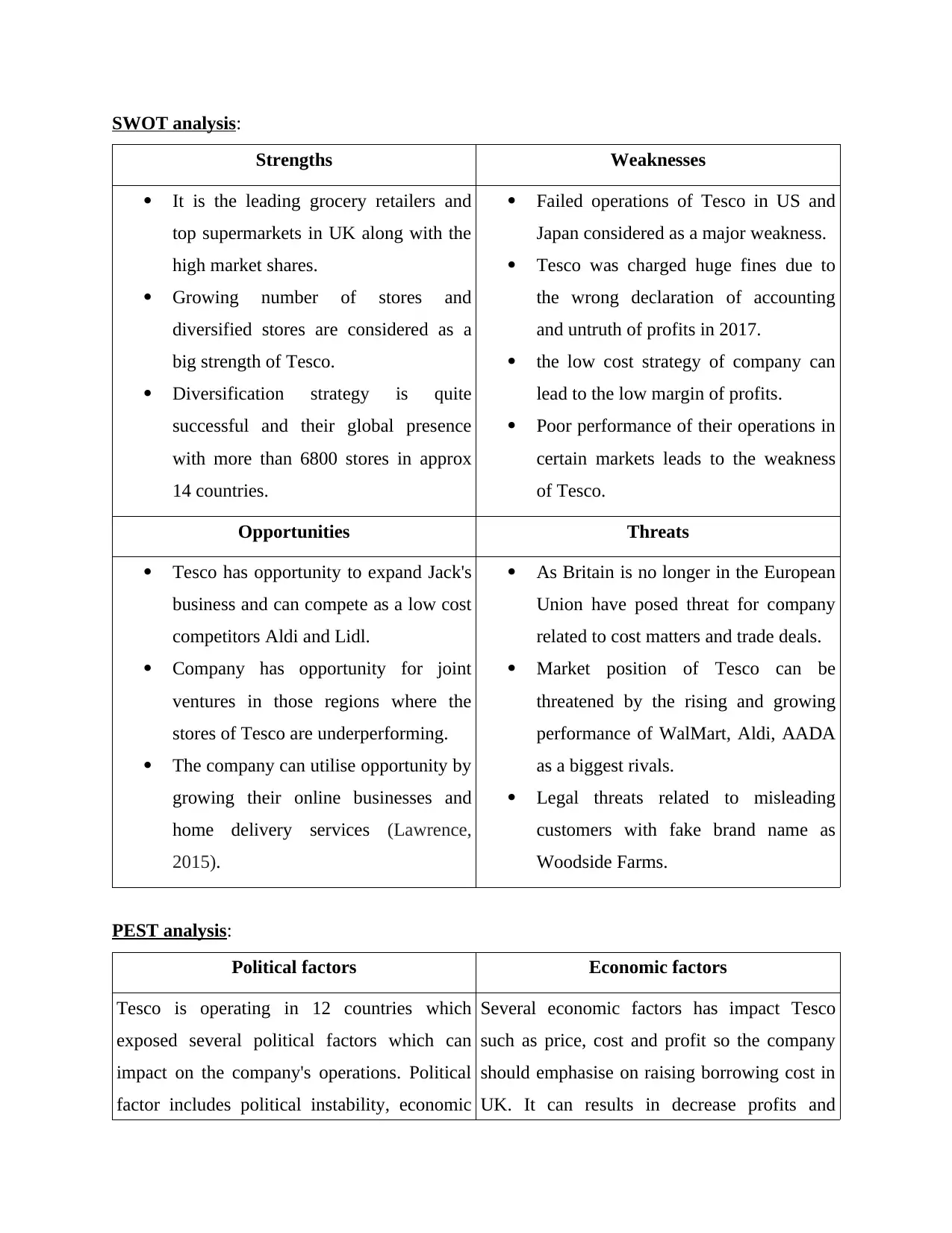
SWOT analysis:
Strengths Weaknesses
It is the leading grocery retailers and
top supermarkets in UK along with the
high market shares.
Growing number of stores and
diversified stores are considered as a
big strength of Tesco.
Diversification strategy is quite
successful and their global presence
with more than 6800 stores in approx
14 countries.
Failed operations of Tesco in US and
Japan considered as a major weakness.
Tesco was charged huge fines due to
the wrong declaration of accounting
and untruth of profits in 2017.
the low cost strategy of company can
lead to the low margin of profits.
Poor performance of their operations in
certain markets leads to the weakness
of Tesco.
Opportunities Threats
Tesco has opportunity to expand Jack's
business and can compete as a low cost
competitors Aldi and Lidl.
Company has opportunity for joint
ventures in those regions where the
stores of Tesco are underperforming.
The company can utilise opportunity by
growing their online businesses and
home delivery services (Lawrence,
2015).
As Britain is no longer in the European
Union have posed threat for company
related to cost matters and trade deals.
Market position of Tesco can be
threatened by the rising and growing
performance of WalMart, Aldi, AADA
as a biggest rivals.
Legal threats related to misleading
customers with fake brand name as
Woodside Farms.
PEST analysis:
Political factors Economic factors
Tesco is operating in 12 countries which
exposed several political factors which can
impact on the company's operations. Political
factor includes political instability, economic
Several economic factors has impact Tesco
such as price, cost and profit so the company
should emphasise on raising borrowing cost in
UK. It can results in decrease profits and
Strengths Weaknesses
It is the leading grocery retailers and
top supermarkets in UK along with the
high market shares.
Growing number of stores and
diversified stores are considered as a
big strength of Tesco.
Diversification strategy is quite
successful and their global presence
with more than 6800 stores in approx
14 countries.
Failed operations of Tesco in US and
Japan considered as a major weakness.
Tesco was charged huge fines due to
the wrong declaration of accounting
and untruth of profits in 2017.
the low cost strategy of company can
lead to the low margin of profits.
Poor performance of their operations in
certain markets leads to the weakness
of Tesco.
Opportunities Threats
Tesco has opportunity to expand Jack's
business and can compete as a low cost
competitors Aldi and Lidl.
Company has opportunity for joint
ventures in those regions where the
stores of Tesco are underperforming.
The company can utilise opportunity by
growing their online businesses and
home delivery services (Lawrence,
2015).
As Britain is no longer in the European
Union have posed threat for company
related to cost matters and trade deals.
Market position of Tesco can be
threatened by the rising and growing
performance of WalMart, Aldi, AADA
as a biggest rivals.
Legal threats related to misleading
customers with fake brand name as
Woodside Farms.
PEST analysis:
Political factors Economic factors
Tesco is operating in 12 countries which
exposed several political factors which can
impact on the company's operations. Political
factor includes political instability, economic
Several economic factors has impact Tesco
such as price, cost and profit so the company
should emphasise on raising borrowing cost in
UK. It can results in decrease profits and
⊘ This is a preview!⊘
Do you want full access?
Subscribe today to unlock all pages.

Trusted by 1+ million students worldwide
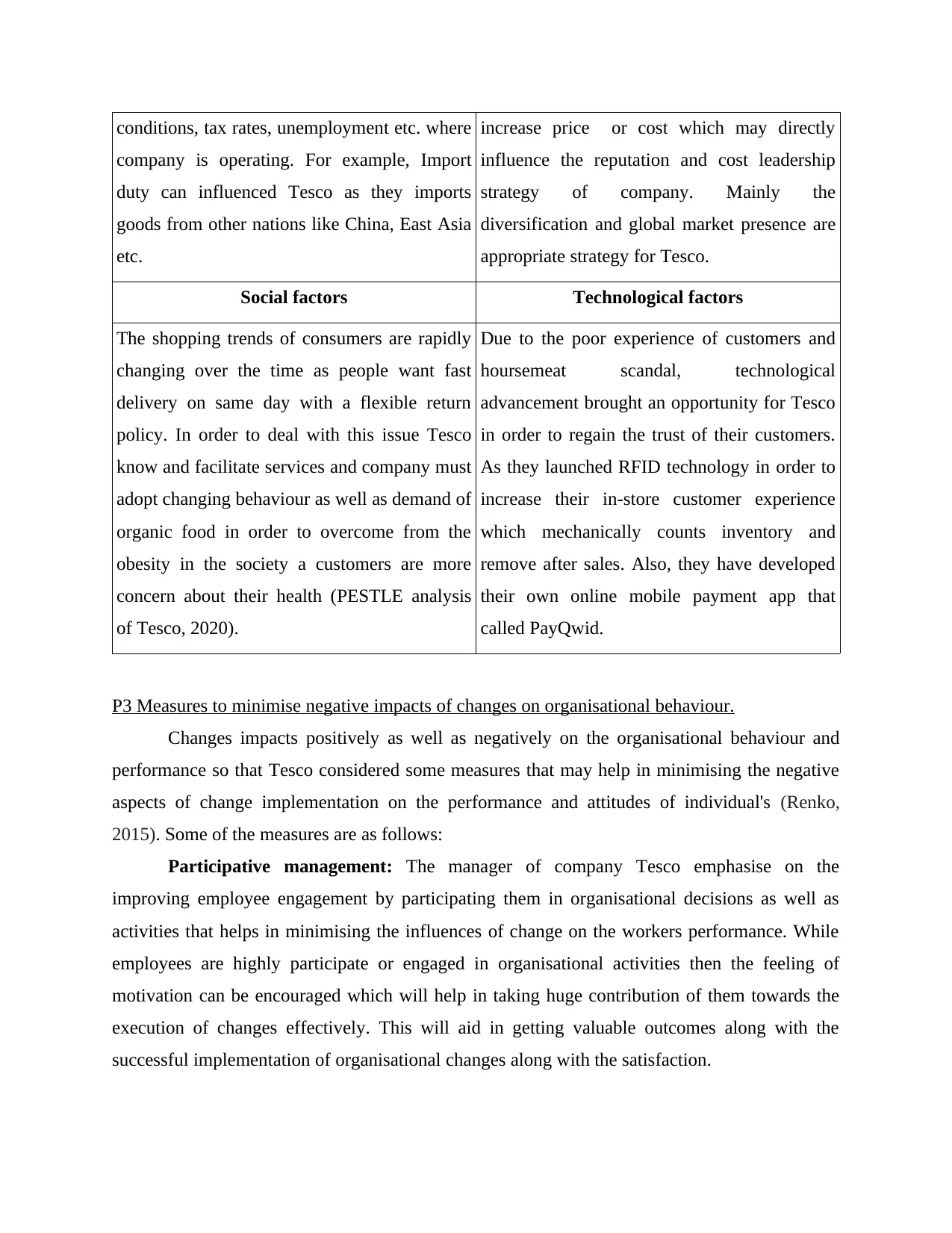
conditions, tax rates, unemployment etc. where
company is operating. For example, Import
duty can influenced Tesco as they imports
goods from other nations like China, East Asia
etc.
increase price or cost which may directly
influence the reputation and cost leadership
strategy of company. Mainly the
diversification and global market presence are
appropriate strategy for Tesco.
Social factors Technological factors
The shopping trends of consumers are rapidly
changing over the time as people want fast
delivery on same day with a flexible return
policy. In order to deal with this issue Tesco
know and facilitate services and company must
adopt changing behaviour as well as demand of
organic food in order to overcome from the
obesity in the society a customers are more
concern about their health (PESTLE analysis
of Tesco, 2020).
Due to the poor experience of customers and
hoursemeat scandal, technological
advancement brought an opportunity for Tesco
in order to regain the trust of their customers.
As they launched RFID technology in order to
increase their in-store customer experience
which mechanically counts inventory and
remove after sales. Also, they have developed
their own online mobile payment app that
called PayQwid.
P3 Measures to minimise negative impacts of changes on organisational behaviour.
Changes impacts positively as well as negatively on the organisational behaviour and
performance so that Tesco considered some measures that may help in minimising the negative
aspects of change implementation on the performance and attitudes of individual's (Renko,
2015). Some of the measures are as follows:
Participative management: The manager of company Tesco emphasise on the
improving employee engagement by participating them in organisational decisions as well as
activities that helps in minimising the influences of change on the workers performance. While
employees are highly participate or engaged in organisational activities then the feeling of
motivation can be encouraged which will help in taking huge contribution of them towards the
execution of changes effectively. This will aid in getting valuable outcomes along with the
successful implementation of organisational changes along with the satisfaction.
company is operating. For example, Import
duty can influenced Tesco as they imports
goods from other nations like China, East Asia
etc.
increase price or cost which may directly
influence the reputation and cost leadership
strategy of company. Mainly the
diversification and global market presence are
appropriate strategy for Tesco.
Social factors Technological factors
The shopping trends of consumers are rapidly
changing over the time as people want fast
delivery on same day with a flexible return
policy. In order to deal with this issue Tesco
know and facilitate services and company must
adopt changing behaviour as well as demand of
organic food in order to overcome from the
obesity in the society a customers are more
concern about their health (PESTLE analysis
of Tesco, 2020).
Due to the poor experience of customers and
hoursemeat scandal, technological
advancement brought an opportunity for Tesco
in order to regain the trust of their customers.
As they launched RFID technology in order to
increase their in-store customer experience
which mechanically counts inventory and
remove after sales. Also, they have developed
their own online mobile payment app that
called PayQwid.
P3 Measures to minimise negative impacts of changes on organisational behaviour.
Changes impacts positively as well as negatively on the organisational behaviour and
performance so that Tesco considered some measures that may help in minimising the negative
aspects of change implementation on the performance and attitudes of individual's (Renko,
2015). Some of the measures are as follows:
Participative management: The manager of company Tesco emphasise on the
improving employee engagement by participating them in organisational decisions as well as
activities that helps in minimising the influences of change on the workers performance. While
employees are highly participate or engaged in organisational activities then the feeling of
motivation can be encouraged which will help in taking huge contribution of them towards the
execution of changes effectively. This will aid in getting valuable outcomes along with the
successful implementation of organisational changes along with the satisfaction.
Paraphrase This Document
Need a fresh take? Get an instant paraphrase of this document with our AI Paraphraser
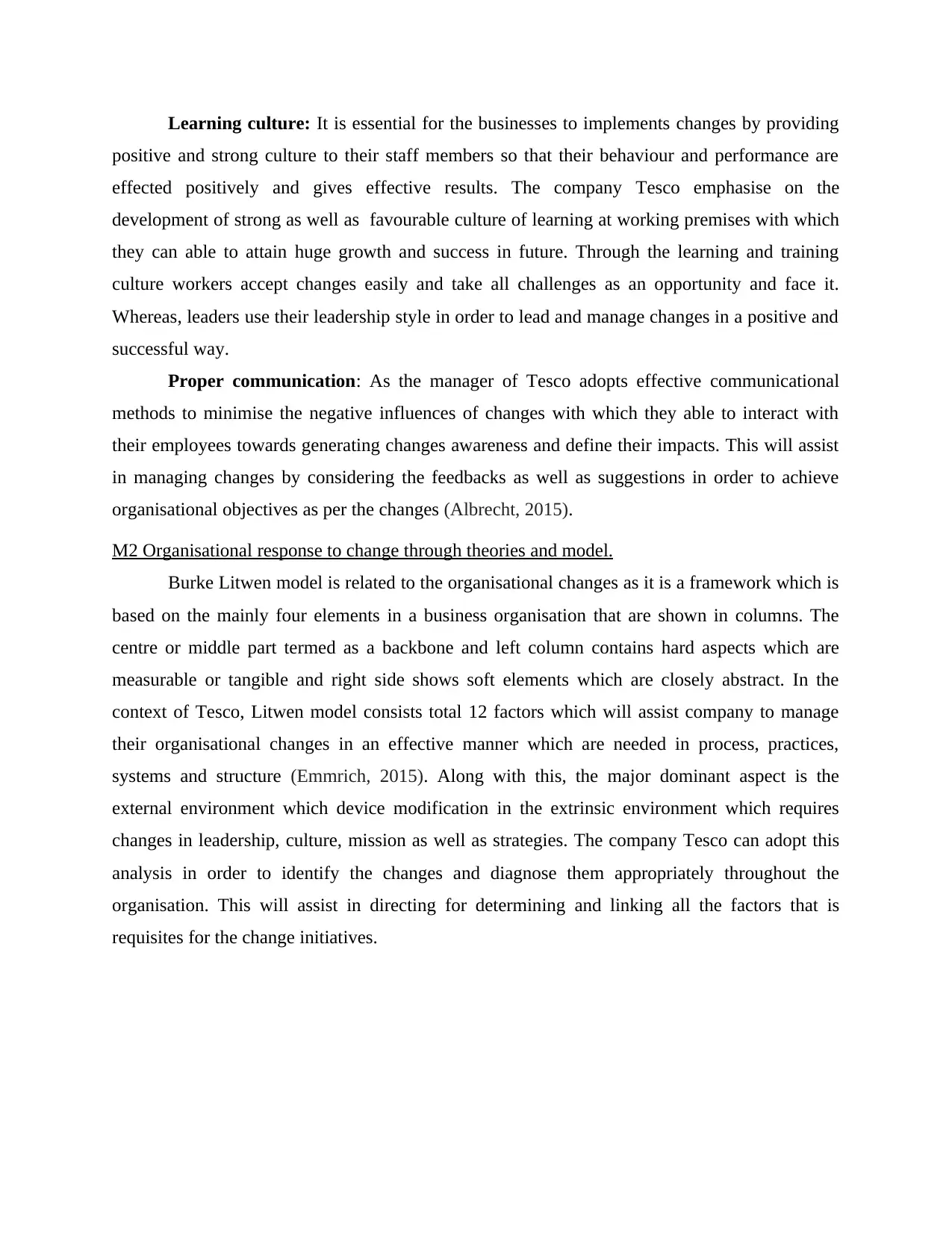
Learning culture: It is essential for the businesses to implements changes by providing
positive and strong culture to their staff members so that their behaviour and performance are
effected positively and gives effective results. The company Tesco emphasise on the
development of strong as well as favourable culture of learning at working premises with which
they can able to attain huge growth and success in future. Through the learning and training
culture workers accept changes easily and take all challenges as an opportunity and face it.
Whereas, leaders use their leadership style in order to lead and manage changes in a positive and
successful way.
Proper communication: As the manager of Tesco adopts effective communicational
methods to minimise the negative influences of changes with which they able to interact with
their employees towards generating changes awareness and define their impacts. This will assist
in managing changes by considering the feedbacks as well as suggestions in order to achieve
organisational objectives as per the changes (Albrecht, 2015).
M2 Organisational response to change through theories and model.
Burke Litwen model is related to the organisational changes as it is a framework which is
based on the mainly four elements in a business organisation that are shown in columns. The
centre or middle part termed as a backbone and left column contains hard aspects which are
measurable or tangible and right side shows soft elements which are closely abstract. In the
context of Tesco, Litwen model consists total 12 factors which will assist company to manage
their organisational changes in an effective manner which are needed in process, practices,
systems and structure (Emmrich, 2015). Along with this, the major dominant aspect is the
external environment which device modification in the extrinsic environment which requires
changes in leadership, culture, mission as well as strategies. The company Tesco can adopt this
analysis in order to identify the changes and diagnose them appropriately throughout the
organisation. This will assist in directing for determining and linking all the factors that is
requisites for the change initiatives.
positive and strong culture to their staff members so that their behaviour and performance are
effected positively and gives effective results. The company Tesco emphasise on the
development of strong as well as favourable culture of learning at working premises with which
they can able to attain huge growth and success in future. Through the learning and training
culture workers accept changes easily and take all challenges as an opportunity and face it.
Whereas, leaders use their leadership style in order to lead and manage changes in a positive and
successful way.
Proper communication: As the manager of Tesco adopts effective communicational
methods to minimise the negative influences of changes with which they able to interact with
their employees towards generating changes awareness and define their impacts. This will assist
in managing changes by considering the feedbacks as well as suggestions in order to achieve
organisational objectives as per the changes (Albrecht, 2015).
M2 Organisational response to change through theories and model.
Burke Litwen model is related to the organisational changes as it is a framework which is
based on the mainly four elements in a business organisation that are shown in columns. The
centre or middle part termed as a backbone and left column contains hard aspects which are
measurable or tangible and right side shows soft elements which are closely abstract. In the
context of Tesco, Litwen model consists total 12 factors which will assist company to manage
their organisational changes in an effective manner which are needed in process, practices,
systems and structure (Emmrich, 2015). Along with this, the major dominant aspect is the
external environment which device modification in the extrinsic environment which requires
changes in leadership, culture, mission as well as strategies. The company Tesco can adopt this
analysis in order to identify the changes and diagnose them appropriately throughout the
organisation. This will assist in directing for determining and linking all the factors that is
requisites for the change initiatives.

(Source: Burke Litwin Change Model, 2020)
D1 Conclusion & recommendations for applying changes and effective planning.
Changes are very important for all businesses as they require to be analysed and with
which effective planning for changes is to be done appropriately by analysing numerous drivers
that may be internal or external. Whereas, change impact analysis is developed by the Bohner &
Armold which is based on the showing potential influences of changes and decide that what
needs to be modified to make changes successfully and effectively (Král, 2016). The manager of
Tesco need to have control over the internal drivers that results in executing external changes
easily which will help company in getting competitive edge within the marketplace. Some of the
recommendations to Tesco for the purpose of effective planning as well as implementing
changes such as follows:
Tesco should adopt effective communication channels so that they properly provide
awareness of changes to their stakeholders.
The company should identify all aspects that may be internal or external as both the
factors has direct impacts and the organisational resources should also be analysed.
The company should emphasise on increasing employee engagement and participate their
employees in the organisational decisions and activities.
D1 Conclusion & recommendations for applying changes and effective planning.
Changes are very important for all businesses as they require to be analysed and with
which effective planning for changes is to be done appropriately by analysing numerous drivers
that may be internal or external. Whereas, change impact analysis is developed by the Bohner &
Armold which is based on the showing potential influences of changes and decide that what
needs to be modified to make changes successfully and effectively (Král, 2016). The manager of
Tesco need to have control over the internal drivers that results in executing external changes
easily which will help company in getting competitive edge within the marketplace. Some of the
recommendations to Tesco for the purpose of effective planning as well as implementing
changes such as follows:
Tesco should adopt effective communication channels so that they properly provide
awareness of changes to their stakeholders.
The company should identify all aspects that may be internal or external as both the
factors has direct impacts and the organisational resources should also be analysed.
The company should emphasise on increasing employee engagement and participate their
employees in the organisational decisions and activities.
⊘ This is a preview!⊘
Do you want full access?
Subscribe today to unlock all pages.

Trusted by 1+ million students worldwide
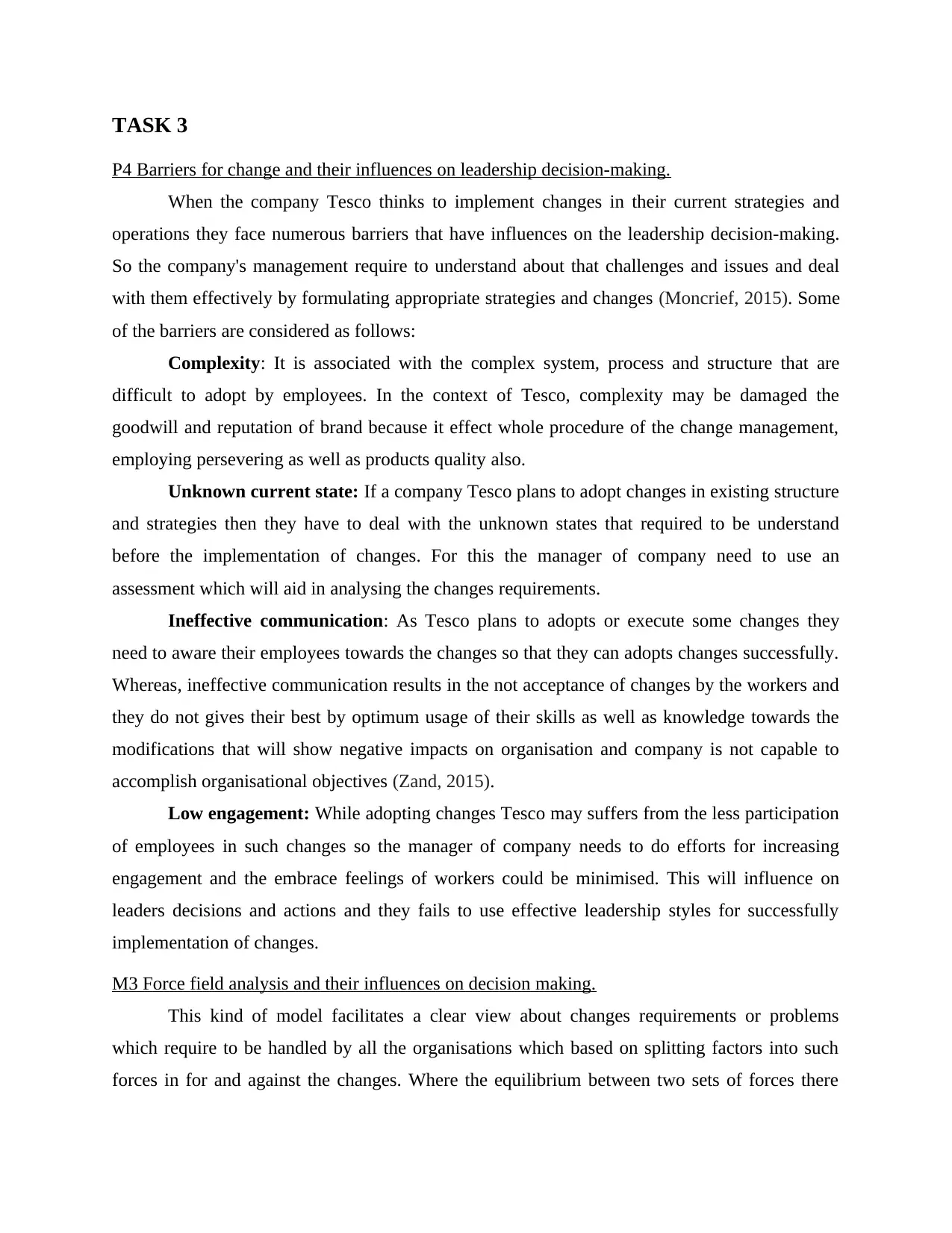
TASK 3
P4 Barriers for change and their influences on leadership decision-making.
When the company Tesco thinks to implement changes in their current strategies and
operations they face numerous barriers that have influences on the leadership decision-making.
So the company's management require to understand about that challenges and issues and deal
with them effectively by formulating appropriate strategies and changes (Moncrief, 2015). Some
of the barriers are considered as follows:
Complexity: It is associated with the complex system, process and structure that are
difficult to adopt by employees. In the context of Tesco, complexity may be damaged the
goodwill and reputation of brand because it effect whole procedure of the change management,
employing persevering as well as products quality also.
Unknown current state: If a company Tesco plans to adopt changes in existing structure
and strategies then they have to deal with the unknown states that required to be understand
before the implementation of changes. For this the manager of company need to use an
assessment which will aid in analysing the changes requirements.
Ineffective communication: As Tesco plans to adopts or execute some changes they
need to aware their employees towards the changes so that they can adopts changes successfully.
Whereas, ineffective communication results in the not acceptance of changes by the workers and
they do not gives their best by optimum usage of their skills as well as knowledge towards the
modifications that will show negative impacts on organisation and company is not capable to
accomplish organisational objectives (Zand, 2015).
Low engagement: While adopting changes Tesco may suffers from the less participation
of employees in such changes so the manager of company needs to do efforts for increasing
engagement and the embrace feelings of workers could be minimised. This will influence on
leaders decisions and actions and they fails to use effective leadership styles for successfully
implementation of changes.
M3 Force field analysis and their influences on decision making.
This kind of model facilitates a clear view about changes requirements or problems
which require to be handled by all the organisations which based on splitting factors into such
forces in for and against the changes. Where the equilibrium between two sets of forces there
P4 Barriers for change and their influences on leadership decision-making.
When the company Tesco thinks to implement changes in their current strategies and
operations they face numerous barriers that have influences on the leadership decision-making.
So the company's management require to understand about that challenges and issues and deal
with them effectively by formulating appropriate strategies and changes (Moncrief, 2015). Some
of the barriers are considered as follows:
Complexity: It is associated with the complex system, process and structure that are
difficult to adopt by employees. In the context of Tesco, complexity may be damaged the
goodwill and reputation of brand because it effect whole procedure of the change management,
employing persevering as well as products quality also.
Unknown current state: If a company Tesco plans to adopt changes in existing structure
and strategies then they have to deal with the unknown states that required to be understand
before the implementation of changes. For this the manager of company need to use an
assessment which will aid in analysing the changes requirements.
Ineffective communication: As Tesco plans to adopts or execute some changes they
need to aware their employees towards the changes so that they can adopts changes successfully.
Whereas, ineffective communication results in the not acceptance of changes by the workers and
they do not gives their best by optimum usage of their skills as well as knowledge towards the
modifications that will show negative impacts on organisation and company is not capable to
accomplish organisational objectives (Zand, 2015).
Low engagement: While adopting changes Tesco may suffers from the less participation
of employees in such changes so the manager of company needs to do efforts for increasing
engagement and the embrace feelings of workers could be minimised. This will influence on
leaders decisions and actions and they fails to use effective leadership styles for successfully
implementation of changes.
M3 Force field analysis and their influences on decision making.
This kind of model facilitates a clear view about changes requirements or problems
which require to be handled by all the organisations which based on splitting factors into such
forces in for and against the changes. Where the equilibrium between two sets of forces there
Paraphrase This Document
Need a fresh take? Get an instant paraphrase of this document with our AI Paraphraser
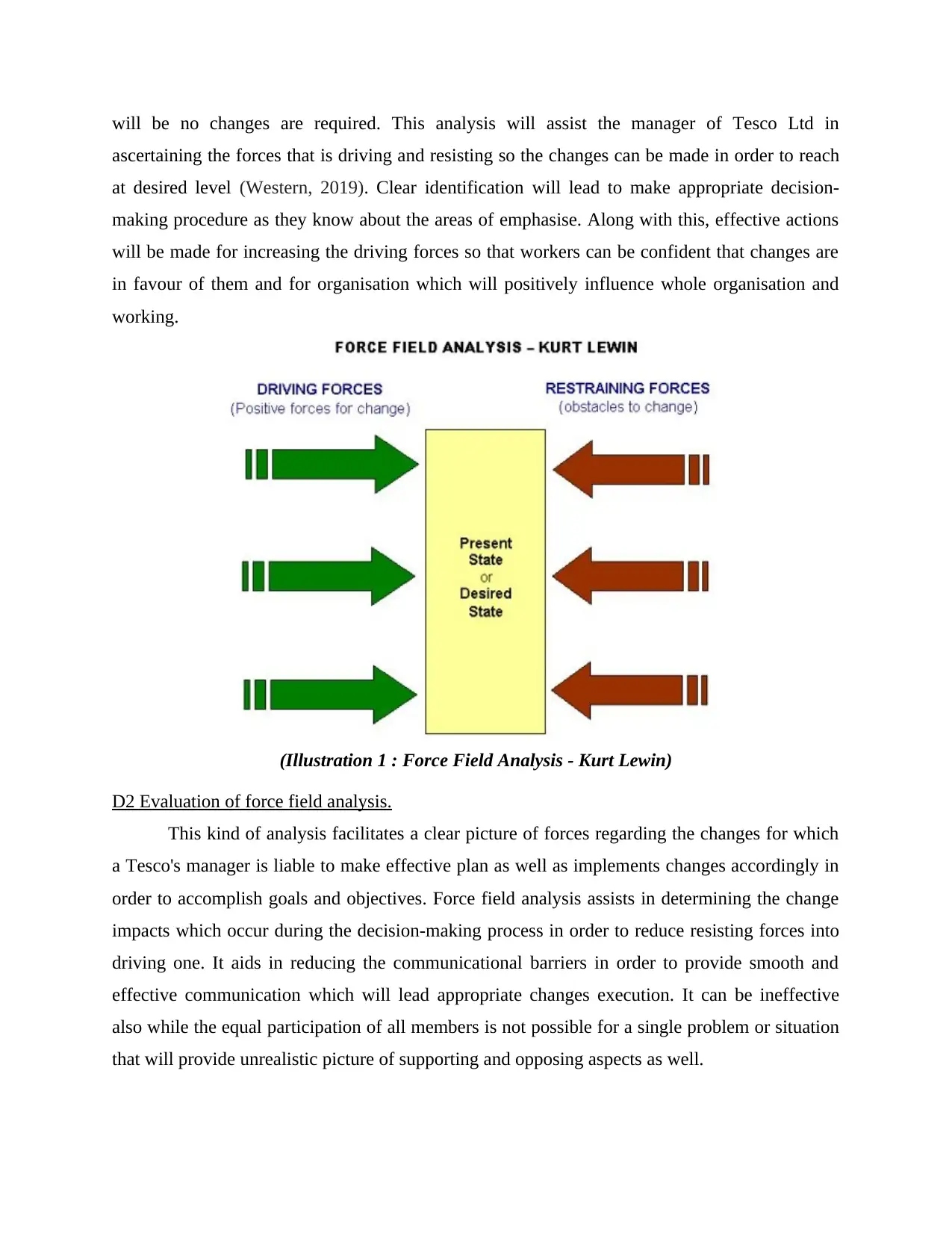
will be no changes are required. This analysis will assist the manager of Tesco Ltd in
ascertaining the forces that is driving and resisting so the changes can be made in order to reach
at desired level (Western, 2019). Clear identification will lead to make appropriate decision-
making procedure as they know about the areas of emphasise. Along with this, effective actions
will be made for increasing the driving forces so that workers can be confident that changes are
in favour of them and for organisation which will positively influence whole organisation and
working.
(Illustration 1 : Force Field Analysis - Kurt Lewin)
D2 Evaluation of force field analysis.
This kind of analysis facilitates a clear picture of forces regarding the changes for which
a Tesco's manager is liable to make effective plan as well as implements changes accordingly in
order to accomplish goals and objectives. Force field analysis assists in determining the change
impacts which occur during the decision-making process in order to reduce resisting forces into
driving one. It aids in reducing the communicational barriers in order to provide smooth and
effective communication which will lead appropriate changes execution. It can be ineffective
also while the equal participation of all members is not possible for a single problem or situation
that will provide unrealistic picture of supporting and opposing aspects as well.
ascertaining the forces that is driving and resisting so the changes can be made in order to reach
at desired level (Western, 2019). Clear identification will lead to make appropriate decision-
making procedure as they know about the areas of emphasise. Along with this, effective actions
will be made for increasing the driving forces so that workers can be confident that changes are
in favour of them and for organisation which will positively influence whole organisation and
working.
(Illustration 1 : Force Field Analysis - Kurt Lewin)
D2 Evaluation of force field analysis.
This kind of analysis facilitates a clear picture of forces regarding the changes for which
a Tesco's manager is liable to make effective plan as well as implements changes accordingly in
order to accomplish goals and objectives. Force field analysis assists in determining the change
impacts which occur during the decision-making process in order to reduce resisting forces into
driving one. It aids in reducing the communicational barriers in order to provide smooth and
effective communication which will lead appropriate changes execution. It can be ineffective
also while the equal participation of all members is not possible for a single problem or situation
that will provide unrealistic picture of supporting and opposing aspects as well.
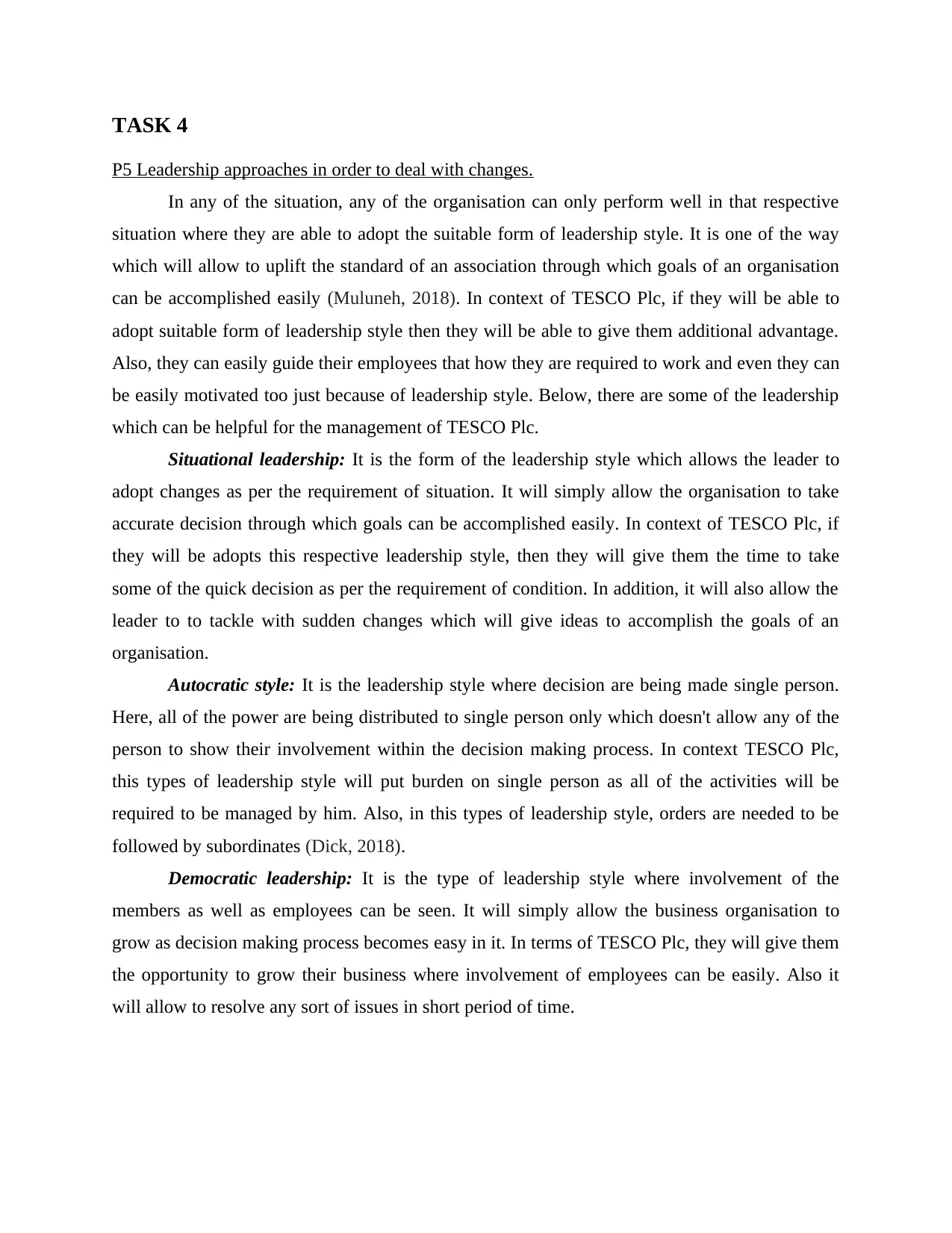
TASK 4
P5 Leadership approaches in order to deal with changes.
In any of the situation, any of the organisation can only perform well in that respective
situation where they are able to adopt the suitable form of leadership style. It is one of the way
which will allow to uplift the standard of an association through which goals of an organisation
can be accomplished easily (Muluneh, 2018). In context of TESCO Plc, if they will be able to
adopt suitable form of leadership style then they will be able to give them additional advantage.
Also, they can easily guide their employees that how they are required to work and even they can
be easily motivated too just because of leadership style. Below, there are some of the leadership
which can be helpful for the management of TESCO Plc.
Situational leadership: It is the form of the leadership style which allows the leader to
adopt changes as per the requirement of situation. It will simply allow the organisation to take
accurate decision through which goals can be accomplished easily. In context of TESCO Plc, if
they will be adopts this respective leadership style, then they will give them the time to take
some of the quick decision as per the requirement of condition. In addition, it will also allow the
leader to to tackle with sudden changes which will give ideas to accomplish the goals of an
organisation.
Autocratic style: It is the leadership style where decision are being made single person.
Here, all of the power are being distributed to single person only which doesn't allow any of the
person to show their involvement within the decision making process. In context TESCO Plc,
this types of leadership style will put burden on single person as all of the activities will be
required to be managed by him. Also, in this types of leadership style, orders are needed to be
followed by subordinates (Dick, 2018).
Democratic leadership: It is the type of leadership style where involvement of the
members as well as employees can be seen. It will simply allow the business organisation to
grow as decision making process becomes easy in it. In terms of TESCO Plc, they will give them
the opportunity to grow their business where involvement of employees can be easily. Also it
will allow to resolve any sort of issues in short period of time.
P5 Leadership approaches in order to deal with changes.
In any of the situation, any of the organisation can only perform well in that respective
situation where they are able to adopt the suitable form of leadership style. It is one of the way
which will allow to uplift the standard of an association through which goals of an organisation
can be accomplished easily (Muluneh, 2018). In context of TESCO Plc, if they will be able to
adopt suitable form of leadership style then they will be able to give them additional advantage.
Also, they can easily guide their employees that how they are required to work and even they can
be easily motivated too just because of leadership style. Below, there are some of the leadership
which can be helpful for the management of TESCO Plc.
Situational leadership: It is the form of the leadership style which allows the leader to
adopt changes as per the requirement of situation. It will simply allow the organisation to take
accurate decision through which goals can be accomplished easily. In context of TESCO Plc, if
they will be adopts this respective leadership style, then they will give them the time to take
some of the quick decision as per the requirement of condition. In addition, it will also allow the
leader to to tackle with sudden changes which will give ideas to accomplish the goals of an
organisation.
Autocratic style: It is the leadership style where decision are being made single person.
Here, all of the power are being distributed to single person only which doesn't allow any of the
person to show their involvement within the decision making process. In context TESCO Plc,
this types of leadership style will put burden on single person as all of the activities will be
required to be managed by him. Also, in this types of leadership style, orders are needed to be
followed by subordinates (Dick, 2018).
Democratic leadership: It is the type of leadership style where involvement of the
members as well as employees can be seen. It will simply allow the business organisation to
grow as decision making process becomes easy in it. In terms of TESCO Plc, they will give them
the opportunity to grow their business where involvement of employees can be easily. Also it
will allow to resolve any sort of issues in short period of time.
⊘ This is a preview!⊘
Do you want full access?
Subscribe today to unlock all pages.

Trusted by 1+ million students worldwide
1 out of 14
Related Documents
Your All-in-One AI-Powered Toolkit for Academic Success.
+13062052269
info@desklib.com
Available 24*7 on WhatsApp / Email
![[object Object]](/_next/static/media/star-bottom.7253800d.svg)
Unlock your academic potential
Copyright © 2020–2025 A2Z Services. All Rights Reserved. Developed and managed by ZUCOL.





